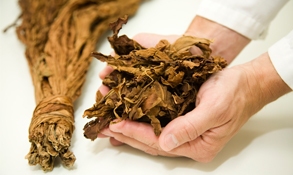*If enjoying an evening at the Berns nightclub in Stockholm, you will find the Berzelii Park named after Jacob Berzelius right outside the window. There's even a statue of him in the centre of the park. He's considered one of the four fathers of modern chemistry. That's exactly how famous this guy was.
Using only the best tobacco, a little salt and water, Jacob named his finest snus "Ljunglöf's No. 1", meaning that is was the Top of the Pops, number one in quality, in short; a display of awesome-ness. This was a standard procedure at the time. Products would be named based on the quality level with the finest being labeled as number 1. Consequently, there would be a number 2, which would be slightly less awesome, and a number 3… well, you get the idea. The Ljunglöf's No. 1 soon got the praise and appreciation it needed. Therefore, consumers just referred to it as Ettan (No. 1). A quite fitting name for a top quality snus, if you ask us.
The secret right in front of your nose
Jacob Ljunglöf created the recipe and the Ettan brand, but it was his son Knut Ljunglöf who with time became known as The King of Snus. There are quite a few stories about the character of the Snus King. Here's one: When testing his snus, Knut used his nose as a quality filter. It was a daily ceremony: In the morning a silver bowl with fresh snus was placed on his desk. He then put a spoon of it under his nose and, with his eyes closed, inhaled. This way he detected the moisture level and quality of the tobacco. If approved, the snus could be packed and sold. If not, the entire batch was thrown away. When asked about the secret behind Ettan's success, Knut would just point to his large nose and say: "My secret? Here it is."
Meet Mr. Perfect
A lot of Knut's personality is permanently embedded into the Ettan brand. Perfection was his thing. He would only eat the finest foods, wear the best clothes that money could buy and lived in a home that would star in a few episodes of "The Crib". But to him, no mission was more important than protecting the quality of Ettan.
Besides putting his snus through the nose-test each morning, he would go to the tobacco fields to test the soil, and then pay a visit to the storage facilities to regulate the temperature and moisture level. And since overnight delivery wasn't available, Knut constantly turned down invites to export Ettan to other countries, simply because he would be unable to guarantee that the product was fresh on arrival. Even if his famous nose is not around anymore, the good folks at Swedish Match now have the technology to ensure that Knut's demands of product quality are met. They also share his passion for perfection -we know that they owe him that.

Rigorous control - from plant to pouch
It starts in the soil. Before someone even puts a seed in it, soil samples are taken to a laboratory in Sweden for analysis. Swedish Match experiments with cultivation in different countries to achieve the best possible raw tobacco. If declared a good soil for tobacco, seeds are planted and every step in the development and the cultivation of the plant is carefully monitored. The tobacco is selected on the basis of seed type, location, climate, leaf position on the plant and curing conditions. When cultivation have started, representatives from Swedish Match will visit the plantations regularly to ensure that the crops will meet the requirements. There's a simple purpose for all this care: To ensure that the tobacco that ends up being selected for the various snus blends from Swedish Match contains the lowest levels of undesirable components possible. This quality control continues through the entire chain of production; when the leaves are harvested and air-cured; when transported and later sorted in a gianormous, perfectly climatized storehouse. Then, finally, the tobacco will find its way to the factory.
When hi-tech meets a 200 year-old tradition.

In step one, the tobacco leaves are crushed and ground to fine grains; the size of the particles varies with the brand. The tobacco is then carefully mixed into a blend. A blend could contain anything between 10 and 30 different grades of tobacco depending on the recipe. In step two, the tobacco is mixed with the other main snus ingredients; water and salt. It's then time for it to undergo heat treatment, (pasteurization). After being chilled the tobacco meets the different ingredients - spices, natural oils or even bourbon whiskey - that will give the snus that extra flavor and special character. And then, finally, it's time for packaging. Loose snus goes straight into the can. For portions the correct amount of snus is first wrapped in a little pouch. In the Swedish Match factories, there is a zero tolerance for errors. Everything - which means everything - is completely focused on delivering top quality. Sophisticated instruments measure and control the process along with watchful and well trained eyes. The tradition of manufacturing snus is 200 years old in Sweden, but there's nothing traditional or old about the Swedish Match production plant. If your nose wouldn't detect the pleasant scent of tobacco here and there in the manufacturing facility, you could easily picture that parts for a fighter jet were being produced instead of snus. They even invented their own quality standard, GothiaTek. And that certainly did not happen because they wanted to make life easy for themselves. It's very much the other way around. Yes, those Swedes are a tough bunch.
What the most simple recipe becomes in the hands of an expert snus blender